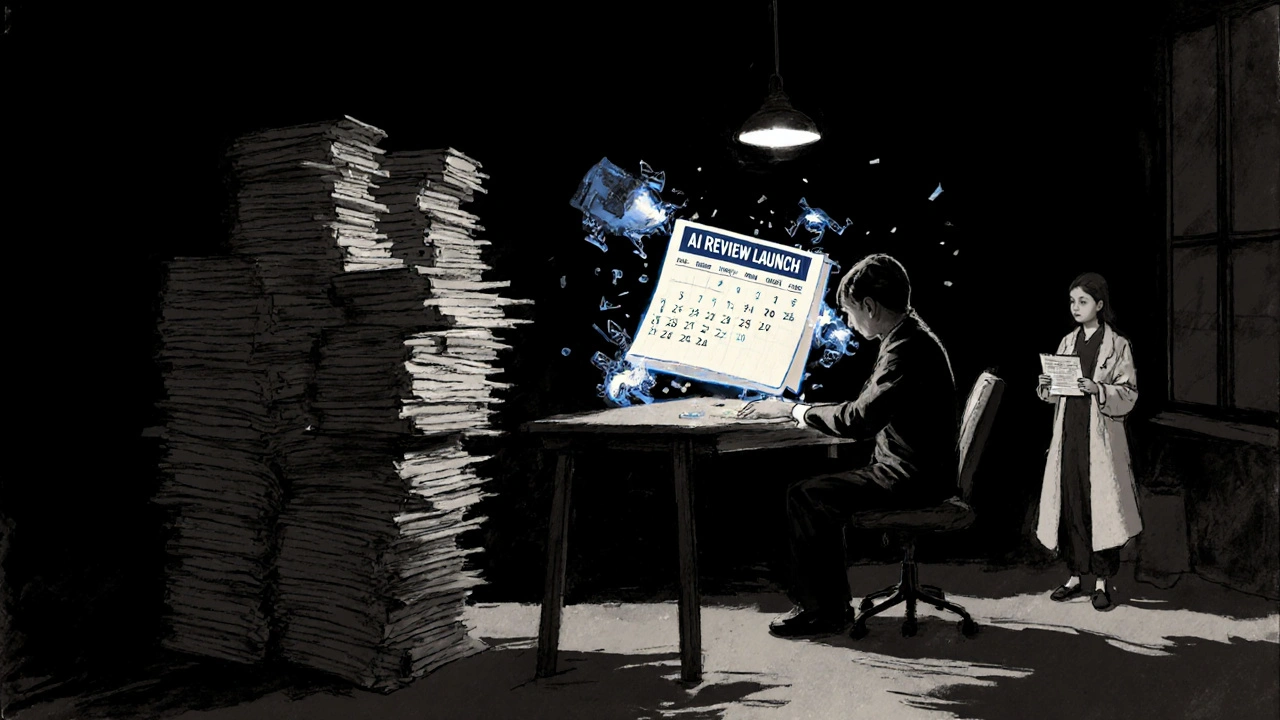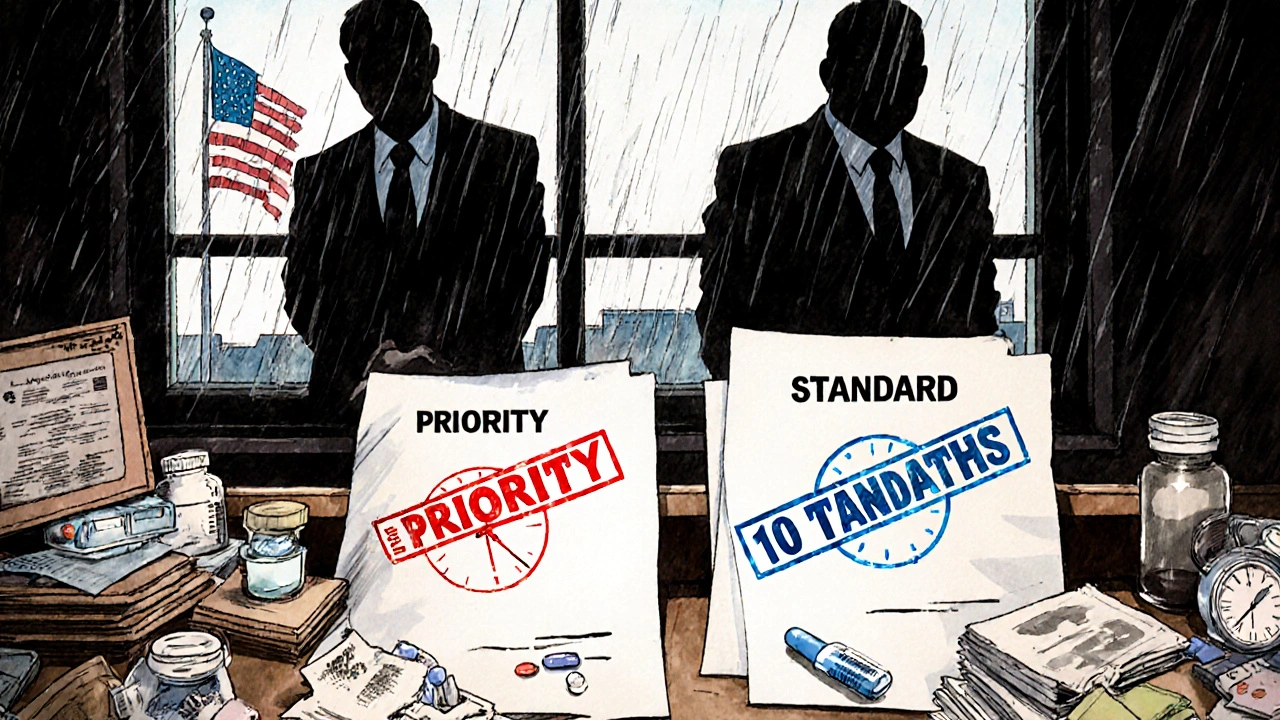When a generic drug hits the market, it’s not just luck-it’s the result of a carefully managed race. The U.S. Food and Drug Administration (FDA) doesn’t treat every generic drug application the same. Some get reviewed in 8 months. Others wait 10 months. That two-month difference can mean millions in revenue, faster access for patients, or even avoiding a drug shortage. But how does the FDA decide which applications get priority?
What’s the difference between priority and standard review?
The FDA uses two tracks for reviewing generic drug applications, known as Abbreviated New Drug Applications (ANDAs). Standard review gives applicants a 10-month timeline to get approval. Priority review cuts that down to 8 months. It sounds simple, but the impact is huge.Under the Generic Drug User Fee Amendments (GDUFA) III, which took effect in October 2022 and runs through 2027, these timelines are locked in. The clock starts ticking the moment the FDA accepts your application as complete. If your paperwork is missing key data, the FDA sends a Refuse-to-Receive letter. You’ll have to pay another $164,880 filing fee and start over. That’s why getting it right the first time matters more than ever.
Standard review covers most generic drugs. If your product isn’t the first version available after a brand-name drug’s patent expires, and it’s not addressing a shortage, you’re in the standard lane. Priority review, on the other hand, is reserved for specific cases: first generics, drugs in short supply, or those that offer a meaningful improvement over existing options.
Who qualifies for priority review?
Not every company can claim priority. The FDA has clear rules. The biggest category is first generics-the first company to submit a complete ANDA after a brand-name drug’s patents and exclusivity expire. These get priority because they’re the gateway to lower prices. In 2022, 92.7% of first generics earned 180 days of market exclusivity, meaning no other generic could compete during that time. That exclusivity window is worth hundreds of millions.The second major reason is drug shortages. If the FDA determines a generic version is needed to prevent or resolve a shortage of a critical medication-like antibiotics, insulin, or chemotherapy drugs-it can fast-track the application. The agency tracks shortages through Section 506C of the Federal Food, Drug, and Cosmetic Act, and responds quickly when a life-saving drug is running low.
There’s also a third, less common path: medically important advances. If a generic version uses a better formulation-say, a more stable tablet, a less irritating injection, or a modified-release version that improves patient adherence-it might qualify. These are rare, but they happen. The FDA doesn’t reward minor changes. It looks for real clinical or safety benefits.
The new U.S. manufacturing priority pilot
In October 2023, the FDA launched something new: the ANDA Prioritization Pilot Program. This isn’t just about speed-it’s about security. The goal? To bring more generic drug manufacturing back to the United States.To qualify, applicants must prove three things: their bioequivalence studies were done in the U.S., their finished dosage forms (the actual pills or injections) are made in the U.S., and their active pharmaceutical ingredients (APIs) come from U.S.-based suppliers. This is a big deal. Right now, 80% of APIs are made overseas, mostly in India and China. The pandemic exposed how fragile that supply chain is.
Companies that meet all three criteria get priority review automatically. That means their 8-month clock starts sooner, and they’re less likely to get stuck in review delays. The FDA estimates this pilot will help 45 to 60 applications per year. But here’s the catch: only 12.3% of generic drug makers currently meet all three requirements, according to FDA facility data.
That’s why big players like Teva, Sandoz, and Hikma are rushing to build U.S.-based testing labs and manufacturing lines. Contract research organizations like PPD and Covance are seeing a 35% jump in U.S.-based bioequivalence studies year over year. It’s expensive, but the payoff is worth it. One executive on Reddit said shifting two products to their Pennsylvania facility could bring $120 million in extra revenue-just from getting approved two months earlier.

Why do so many applications get rejected?
Getting approved isn’t just about timing. It’s about quality. In 2022, nearly one-third (31.7%) of ANDAs received at least one Complete Response Letter (CRL), meaning the FDA found problems that had to be fixed before approval. The biggest culprit? Chemistry, manufacturing, and controls (CMC) issues-47.2% of all delays.That includes things like inconsistent tablet hardness, unstable packaging, or impurities in the API. Even small deviations can trigger a CRL. The average ANDA goes through 1.7 review cycles before approval. Each cycle adds about 4.2 months to the timeline. That’s why more companies are turning to pre-submission meetings with the FDA.
In 2020, only 41% of sponsors requested these early discussions. By 2023, that number jumped to 63%. Those who do get more first-cycle approvals-up from 24.1% to 38.7%. It’s like getting feedback before submitting your final exam. You fix the mistakes early, and you don’t fail.
What about complex generics?
Not all drugs are created equal. Simple pills? Easy to copy. Inhalers, topical creams, injectables with complex delivery systems? Not so much. These are called complex generics, and they make up 18.3% of pending ANDAs but only 9.7% of approvals. Why? Because proving bioequivalence is harder. The FDA can’t just compare blood levels-they have to test how the drug behaves in the body, how it’s absorbed, how it’s released.To help, the FDA started the Complex Generic Drug Product Pilot Program in January 2023. It gives sponsors early scientific advice on how to design their studies. Companies that use this program report fewer CRLs and faster approvals. It’s a smart move-complex generics are where the next wave of savings will come from. If you can make a generic version of an expensive inhaler, you’re not just saving money-you’re changing lives.

What’s next for FDA generic reviews?
The FDA is getting smarter. By Q3 2024, it plans to roll out AI-assisted tools to help review straightforward ANDAs faster. In internal tests, these tools reduced review times by 18.7%. That means simpler applications-like generic aspirin or metformin-could get approved even quicker than 8 months.Industry analysts predict that by 2026, these changes will cut the average time to generic approval by 4.3 months. That could save the U.S. healthcare system $18.7 billion a year. The FDA also wants to increase the share of U.S.-made generic drugs from 28% to 40% within five years. That’s ambitious, but the incentives are clear: if you make it here, you get reviewed faster.
Meanwhile, the number of ANDA submissions keeps rising. The FDA expects 1,275 applications in FY 2024-a 12.5% jump. Priority reviews are growing even faster. In 2020, only 21.1% of approvals were priority. By 2022, that number was 28.4%. And it’s still climbing.
What does this mean for patients and providers?
It means more affordable drugs, faster. When a first generic enters the market, brand-name drug prices often drop by 50% or more within months. A 2022 report from IQVIA showed that generics filled 88.6% of all prescriptions in the U.S.-but cost only 15.3% of total spending. That’s the power of competition.When a drug shortage is avoided because a generic arrived on time, it’s not just a regulatory win-it’s a health win. Patients don’t have to switch treatments. Hospitals don’t have to ration. Doctors don’t have to guess.
The system isn’t perfect. Delays still happen. Complex drugs still lag. But the FDA’s tools-priority review, the manufacturing pilot, pre-submission meetings, and AI-are making it better. For generic manufacturers, the message is clear: plan ahead, invest in U.S. capacity, and get expert advice early. For patients, the result is simple: more access, lower costs, and fewer shortages.
What’s the main difference between priority and standard review for generic drugs?
The main difference is the review timeline. Standard review takes up to 10 months from submission, while priority review is capped at 8 months. Priority review is only available for first generics, drugs in shortage, or those offering a meaningful clinical advantage. The two-month difference can mean millions in revenue and faster patient access.
How does the FDA decide if a generic drug qualifies for priority review?
The FDA grants priority review to ANDAs that are first generics (no other generic on the market), address a documented drug shortage, or represent a medically important improvement over existing versions. The agency checks patent and exclusivity status through the Orange Book database and reviews shortage data from its own monitoring system. Only applications that meet these specific criteria are eligible.
What is the ANDA Prioritization Pilot Program?
The ANDA Prioritization Pilot Program, launched in October 2023, gives priority review to generic drug applications that conduct bioequivalence testing in the U.S., manufacture finished dosage forms in the U.S., and use U.S.-sourced active pharmaceutical ingredients (APIs). It’s designed to strengthen domestic supply chains and reduce reliance on foreign manufacturing. Companies that meet all three criteria automatically receive priority review status.
Why do so many generic drug applications get rejected or delayed?
About 31.7% of ANDAs receive at least one Complete Response Letter (CRL), mostly due to Chemistry, Manufacturing, and Controls (CMC) issues. These include problems with tablet stability, impurity levels, packaging integrity, or inconsistent manufacturing processes. Each CRL adds about 4.2 months to the timeline. Many companies now use pre-submission meetings with the FDA to avoid these pitfalls.
Are complex generics harder to get approved than simple pills?
Yes. Complex generics-like inhalers, topical creams, and modified-release injections-are harder to prove bioequivalent because their behavior in the body isn’t just about blood levels. They require specialized testing. While they make up 18.3% of pending applications, only 9.7% have been approved. The FDA’s Complex Generic Drug Product Pilot Program helps sponsors get early feedback to improve success rates.
Is the FDA using AI to speed up generic drug reviews?
Yes. The FDA is piloting AI tools to review simpler ANDAs, reducing review times by 18.7% in internal tests. These tools help automate checks for common data gaps, labeling errors, and standard CMC issues. Full rollout is expected by Q3 2024. AI won’t replace reviewers, but it will help them focus on complex problems, speeding up approvals for straightforward applications.




Gabriella Jayne Bosticco
November 17, 2025 AT 16:34Honestly, I never realized how much goes into getting a generic drug approved. That two-month difference can literally mean life or death for someone waiting on insulin. The FDA’s system isn’t perfect, but at least they’re trying to make it fairer.
Sarah Frey
November 18, 2025 AT 17:15It is imperative to acknowledge the structural incentives embedded within the Generic Drug User Fee Amendments (GDUFA) III framework, which effectively align regulatory efficiency with public health outcomes. The prioritization of first generics and shortage medications represents a commendable convergence of economic and humanitarian objectives.
Katelyn Sykes
November 20, 2025 AT 08:51U.S. manufacturing is the way to go period. If you make it here you get faster approval and that’s just smart. No more waiting 6 months for pills that come from some factory in India that got shut down during a heatwave. We need our meds made here
Gabe Solack
November 22, 2025 AT 06:54Big respect to the FDA for pushing U.S. manufacturing 🙌 I work in pharma logistics and trust me the supply chain chaos during the pandemic was wild. Seeing companies invest in U.S. labs? That’s the future. Also pre-submission meetings? DO THEM. Save yourself the headache.
Yash Nair
November 23, 2025 AT 19:12Why are we letting americans get priority when india makes 80% of the world's generics? This is pure protectionism. We have the best chemists here and you are throwing money away building labs in pennsylvania when you can get it done in hyderabad for 1/10 the cost. Stop this american first nonsense
Bailey Sheppard
November 24, 2025 AT 22:11I love seeing the FDA actually adapt. Pre-submission meetings and AI tools? That’s how you fix a broken system without burning everyone out. It’s not about speed for speed’s sake-it’s about getting safe, affordable drugs to people who need them. Small steps, big impact.
Girish Pai
November 25, 2025 AT 21:00The GDUFA III framework leverages a tiered regulatory architecture predicated upon bioequivalence validation protocols and API provenance compliance. The prioritization algorithm, calibrated via ORANGE BOOK cross-referencing and 506C shortage metrics, dynamically optimizes throughput for first-to-file ANDAs. The manufacturing pilot constitutes a supply chain resilience heuristic aligned with national security imperatives.
Kristina Williams
November 27, 2025 AT 06:39They’re using AI to review pills? That’s a lie. The FDA is just trying to hide how they’re letting Chinese companies slip in dangerous stuff. They’re cutting corners so Big Pharma can make more money. You think your metformin is safe? It’s probably laced with carcinogens from a factory that doesn’t even wash the machines between batches.
Shilpi Tiwari
November 28, 2025 AT 21:03The complexity of bioequivalence for inhalers and topical formulations is underappreciated. The pharmacokinetic profiles require in vivo testing with advanced modeling, not just HPLC comparisons. The pilot program’s inclusion of in vitro-in vivo correlation (IVIVC) frameworks is a paradigm shift-finally addressing the gap between lab data and clinical outcomes.
Christine Eslinger
November 30, 2025 AT 11:10It’s funny how we think of drugs as just chemicals, but they’re really stories-stories of patients waiting, of families choosing between rent and refills, of hospitals rationing because the supply chain snapped. The FDA’s moves aren’t just policy-they’re acts of care. Making it here, getting it right, helping people faster? That’s not bureaucracy. That’s humanity in action.
Holly Powell
December 2, 2025 AT 03:51Let’s be real-the entire system is a charade. Priority review? Just a marketing tool for big pharma to monopolize the market longer. The "medically important improvement" clause? Mostly just reformulations with a different coating. And don’t get me started on the U.S. manufacturing pilot-it’s a $2 billion boondoggle that won’t change a thing.
Emanuel Jalba
December 4, 2025 AT 00:17THEY’RE HIDING THE TRUTH 😭 The FDA is in bed with Big Pharma and they’re letting dangerous generics slip through just to save time. My cousin died because his generic blood thinner wasn’t tested right. This isn’t regulation-it’s a death sentence wrapped in a flowchart. #FDAFail #GenericDrugScam
Heidi R
December 5, 2025 AT 20:56Priority review is just a bribe for companies that lobby hard enough.
Brenda Kuter
December 5, 2025 AT 21:58I knew it! This whole thing is a trap. They’re pushing U.S. manufacturing so they can raise prices later under the guise of "national security." They’re lying to us. I read a post on a forum that said the FDA’s AI tools are already being used to approve unsafe drugs faster. Don’t believe the hype. They’re not helping us-they’re controlling us.
Shaun Barratt
December 7, 2025 AT 05:42While the implementation of AI-assisted review mechanisms demonstrates a commendable advancement in regulatory efficiency, one must remain cognizant of the inherent limitations of algorithmic decision-making in contexts involving human health. The integration of machine learning models must be accompanied by rigorous validation protocols and continuous human oversight to mitigate potential systemic biases and ensure patient safety remains paramount.